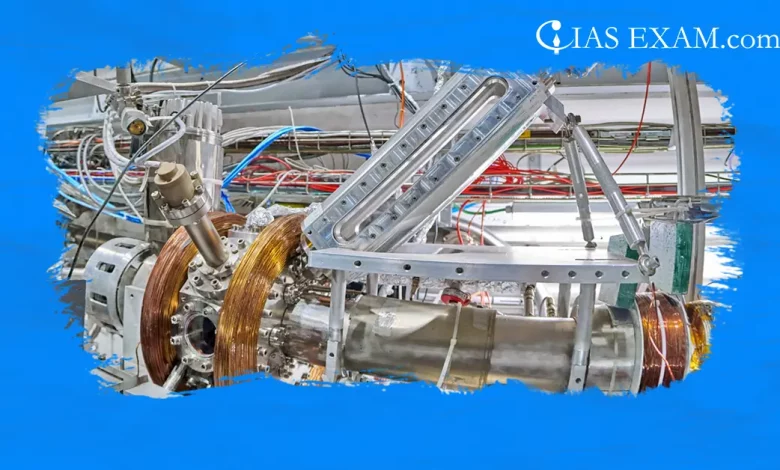Daily Current Affairs for UPSC
Laser cooling of Positronium
Syllabus- Science and Technology [GS Paper-3]

Context
An international team of physicists from the Anti-hydrogen Experiment: Gravity, Interferometry, Spectroscopy (AEgIS) collaboration has recently achieved a breakthrough by demonstrating the laser cooling of Positronium.
About
- Physicists representing the Antihydrogen Experiment: Gravity, Interferometry, Spectroscopy (AEgIS) collaboration introduced this scientific success.
- AEgIS is a collaboration of physicists from 19 European and one Indian research group.
- The primary scientific goal of the AEgIS is the direct measurement of the Earth’s gravitational acceleration based on antihydrogen.
The experiment
- The experiment was achieved at the European Organization for Nuclear Research, more popularly referred to as CERN, in Geneva.
- Experimentalists carried out laser cooling of Positronium atoms first of all from ~380 Kelvin to ~170 Kelvin, and demonstrated the cooling in one dimension using a 70-nanosecond pulse of the alexandrite-based laser system.
- The lasers deployed, researchers said, have been both within the deep ultraviolet or in the infrared frequency bands.
Note
- Positronium, comprising a certain electron ( e- ) and positron ( e ), is a fundamental atomic system.
- Due to its very short life, it annihilates with a half life of 142 nano-seconds.
- Its mass is twice the electron mass and enjoys the particular distinction of being a pure leptonic atom.
- This hydrogen-like system, with halved frequencies for excitation, makes it an incredible contender for trying laser cooling and thereby performing checks of essential theories in physics.
Significance
- This is an important precursor experiment to the formation of antiHydrogen and the size of Earth’s gravitational acceleration on antihydrogen in the AEgIS experiment.
- In addition, this scientific feat should open potential possibilities to supply a gamma-ray laser that might subsequently permit researchers to look inside the atomic nucleus and have applications beyond physics.
- This experiment will pave the way for acting spectroscopic comparisons required for the Quantum Electrodynamics (QED), the examination of the light and its interplay with charged count number, and a likely degenerate gas of Positronium down the street.
- According to CERN, the new scientific development will allow excessive-precision measurements of the properties and gravitational behaviour of this uncommon yet simple rely–antimatter system, that could screen more modern physics.
- It additionally lets in the manufacturing of a positronium Bose–Einstein condensate, wherein all ingredients occupy the same quantum state.
- Such a condensate has been proposed as a candidate to supply coherent gamma-ray mild made of monochromatic waves which have a constant phase difference between them.
Source: The Indian Express
UPSC Prelims Practice Question:
Q.The efforts to detect the existence of the Higgs boson particle have become frequent news in the recent past. What is/are the importance of discovering this particle?
- It will enable us to understand why elementary particles have mass.
- It will enable us in the near future to develop the technology of transferring matter from one point to another without traversing the physical space between them.
- It will enable us to create better fuels for nuclear fission.
Select the correct answer using the codes given below:
a. 1 only
b. 2 and 3 only
c. 1 and 3 only
c. 1, 2 and 3
Ans: “a”





.png)



